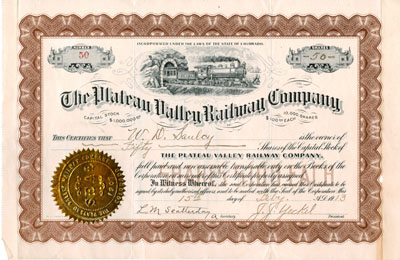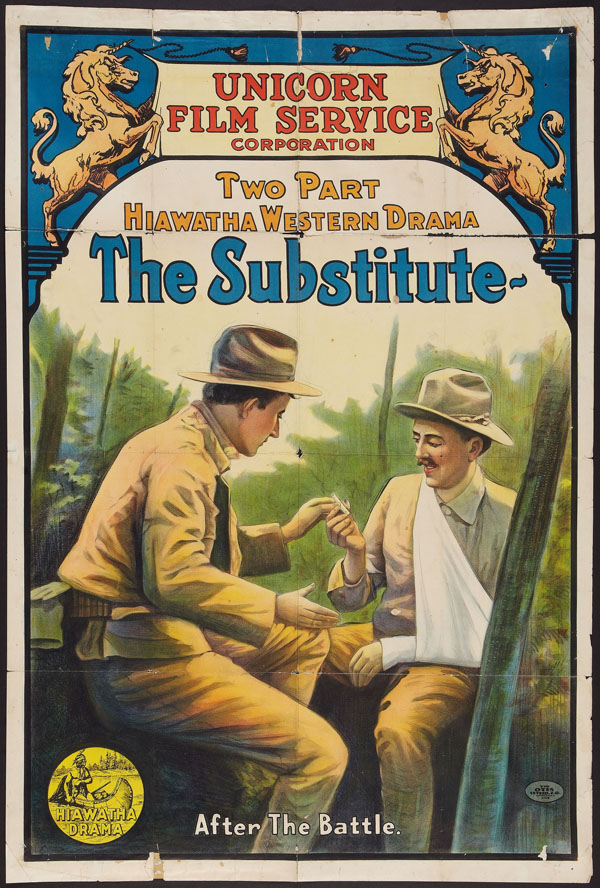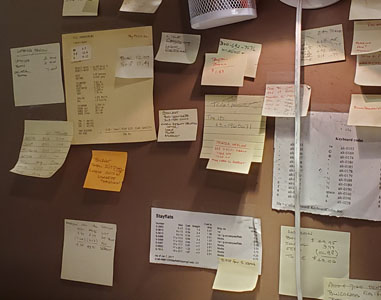Rarity
Is it important to quantify rarity?
I think most collectors, in almost every corner of the collecting world, enjoy having some way of measuring rarity. WHY collectors want that information, is less clear, although rarity is almost always tied to concepts of value and price.
 This certificate from The Plateau Valley Railway Co is the only one I've ever encountered. What is its real population? is it unique? Anyone willing to bet? Purchase price: $1 on eBay plus postage.
This certificate from The Plateau Valley Railway Co is the only one I've ever encountered. What is its real population? is it unique? Anyone willing to bet? Purchase price: $1 on eBay plus postage.
It seems nearly universal that collectors value the feeling of owning rare things. It gives them pleasure. It fulfills a thrill of the hunt. It fosters a pride in owning something that few people will ever be able to experience. That does not mean eveyone enjoys paying the cost of rare things.
It is the cost of owning rarity that underpins the need to measure rarity.
It is a near-universal belief that rare things cost more than common things. Ask practically anyone, collector or not, and they will argue that rare things cost more than common things. In other words, there is a widespread belief that rarity is the primary driver of price. I call that belief the Rarity Myth.
Few people seem to realize that almost everyone owns things that are very rare.. Even unique. They include photographs, keepsakes, letters, diaries, family Bibles, and similar items of personal importance. As rare as they may be, most of those things have little, if any, value to anyone else. And yet, they are priceless to the owner. In other words, there are millions of things of ultimate rarity that have no external sales value whatsoever.
That means there is something else, some special sauce, that stands between rarity and value. Between value and price. And between rarity and price.
I call that desire.
- Personal desire can connect a single fixed value with items of radically different rarities.
- Personal desire can connect items of identical rarities with radically different values.
Trying to associate rarity directly with price is a recipe for disappointment. I call that the "rarity myth,"
The rarity myth:
The scarcer an item, the more it is "worth."
Please understand, I am not saying the rarity and price are disconnected. They are simply connected through the lens of personal desire. And every person should know by now that desire is a highly powerful, and yet highly flexible, motivation. (Please see a deeper discussion of rarity and price at "Rarity myth.")
What is rarity?
"Rarity" is, with special exceptions, an imprecise and general measurement of population. Take for instance, the 1914-D Lincoln cent. While 1,193,000 were minted, only about 120,000 survive today. It is considered very rare in the highest conditions and a very scarce key coin among coin collectors.
The 1804 silver dollar, popularly known as "The King of American Coins," has a known population of 15. Six are held by museums and nine remain in private hands. Sufficiently wealthy buyers had a chance to purchase an example eight different times between 1980 and today, or about once every five years. Stack's Bowers Galleries sold the finest known example for $7.68 million in 2021.
In the scripophily hobby, acquiring a certificate of that rarity in not even challenging. There are over 2,000 (!) VARIETIES of that rarity among certificates issued by railroad companies. There are another 1,000 if consider major sub-varieties. I stress that any collector staying in this hobby for five years will end up owning at least one certificate of the rarity equal to or greater than the 1804 silver dollar.
Is it possible to engineer a "rarity system" for certificates?
Kinda.
Let's be clear. With the possible exception of the 1804 silver dollar and other select collectibles, rarity systems depend entirely on estimates. With the possible exception of very high-ticket art, I cannot think of any popular collecting hobby where there is an ability to precisely quantify how many collectibles exist. Estimates concerning rarity depend on the experiences of estimators. Only through experiences in tracking availability can they gain insight into how many items might exist, Only by tracing appearances of new items can they estimate how many more undiscovered items might appear. The deeper and longer their experience, the better they can get at estimating something that is inherently unknowable.
In our hobby, unlike the mature hobbies of coins, stamps, and paper money, there is a concern that unreported hoards might still exist. Since the population of active collectors is very low, even the appearance of "mini-hoards," has been known to affect prices.
Let's be clear. The very best estimations of rarity are nonetheless guesses. After all, who can possibly guarantee that all the large hoards have already been released and absorbed?
It is not just hoards, large or small, that are unknown. Who can say they know how many certificates are hiding in dealer inventories around the world? And what about certificates already held by collectors?

Dealers and experienced collectors understand that rarity estimates are exactly that. I have often compared the problem of estimating the number of unknown certificates as being similar to estimating how many green jelly beans are in a jar, when you can't see the jar.
Advanced collectors fully understand that that rarity estimates are guidelines about relative populations and nothing more. Advanced collectors already know that it is impossible to estimate the numbers of unseen certificates. My reluctance to estimate rarity does not lie with advanced collectors of great experience. My big problem is trying to avoid misleading new and intermediate collectors. And it is clear that new and intermediate collectors consider rarity estimates differently than old-timers.
I've heard questions such as
- "This certificate is supposed to more rare than that one, so why is the common one priced higher?"
- "This cetificate is supposed to be really rare! Why so cheap?"
Questions like that are normal and simply illustrate two time-worn misconceptions:
- price and rarity are connected,
- rarity estimates are more accurate than they really are.
Experienced collectors appreciate that rarities of certificates can and do change. Rarities can decrease with the appearance of new corporate hoards and liquidation of dealer inventories. Even the addition of ten or fifteen certificates can change the perception of rarity if they appear on the market in quick succession. Collectibles can become more rare when they are removed from the collectors' marketplace by donations to museums and historical societies. Even in the absence of purposeful removal, populations of delicate collectibles constantly decrease with inevitable losses to natural and man-made disasters and yet, might not be felt by the market for years
"Rarity systems" are estimates, and authors generally say so. Rarity estimates can can age poorly if there is no way to update them. Still, many collectors yearn for some sense of relative rarity, even if estimates might be old and out of date. Therefore...
I released a substitute system for rarity in May, 2017
By that time, the hobby was almost forty years old and I had cataloged 20,858 varieties and sub-varieties of railroad certificates. 362 "new" varieties had appeared during the previous twelve months, so I knew I needed a way to continually keep rarity estimates fresh. By May, 2017, I had records of 1,022,581 certificate appearances going back to 1980 — along with their dates.
 Hiawatha Film Company / Unicorn Film Service, Public domain, via Wikimedia Commons
Hiawatha Film Company / Unicorn Film Service, Public domain, via Wikimedia Commons
Serial numbers were known for only 15% of the recorded appearances, so estimating actual rarity was a non-starter. There was no way I was going to estimate relative populations of certificates hidden in dealer inventories and collections across North American and Europe.
Nonetheless, the database was growing large and I had sufficient information to quantify how often items had come up for sale, been purchased, or otherwise reported.
What I could do with that information was create a system that calculated the number of times any variety had made an appearance since 1980. Since the future tends to imitate the past, I could use that information to estimate how often every variety and sub-variety was likely to appear in the future.
My working theory was that if collectors wanted to acquire specific varieties of certificates, my system could suggest how long they might need to wait to see one for sale. Could they call up a dealer and find one tomorrow? Or would they possibly need to wait ten years? If they were unable to buy the first certificate that appeared, what would be their statistical waiting time before they saw another?
In other words, a frequency-of-appearance system could tell them something that an ordinary rarity system could not. Moreover, the system could be automatically freshened every time the database was updated.
Obviously, a certificate that is constantly available is common. It seemed equally reasonable to assume that a certificate that has appeared only one time in ten years is probably scarcer than one that appears once every five years.
I subsequently designed a method of calculating the average number of days between appearances of every variety. I did not believe in making wild guesses about rarity, but reasoned that gross ranges of the frequency of appearances would be a reasonable stand-in for a rarity system based on estimates. I had no ability to catalog every appearance of a North American railroad certificate sold around the world. Nonetheless, I thought that the amount of time and resources I could dedicate to finding and recording certificates should correlate adequately with the abilities of my readers to locate, bid on, and purchase those same certificates.
After examining numerous rarity systems for several collectible hobbies, I discovered that most systems were normally numbered from low (common) to high (rare.) I felt that rarity systems that were split into too many categories implied a greater accuracy than I believed possible. Conversely, I felt that too few divisions resulted in rarity estimates that were too wide to be usable.
So I decided,
- to divide appearances of certificate varieties into seven gross units of time,
- to number the likelihood of appearances from common to rare,
- to call my measuring system a "rarity system" because that was what collectors were used to.
It was the last decision that caused me concern and one that bothered me continually, because...
My system was NOT a rarity system at all
It was a frequency of appearances system. Even though I explained my system of measuring appearances as thoroughly as I could, confusion about the word "rarity" persisted. It was true that my system could be used as a substitute for a rarity system, as long as users understood that that I do not estimate possible populations. Instead, I use my database to count appearances of all varieties of certificates that I have had time to record. The database simply calculates how frequently varieties and sub-varieties have historically appeared for sale.
Re-branding the system
At the December 1, 2021 database update, I renamed my calculation system a "frequency of appearance system" to emphasize what the system really is.
Regardless of where anyone stands on the usefulness of rarity estimates or frequency of appearance estimates, I believe there are two inescapable facts about estimating rarities of collectibles.
- Precise numbers of specific collectibles are seldom known.
- Rarity estimates depend on the experiences of estimators.
My frequency of appearance system is a seven-point system
I arrange the system order from most commonly seen to most rarely seen. In my experience, it makes sense to talk about very rare items being "high-rarity." Consequently, I use higher numbers for items of that appear very infrequently, and are therefore probably more rare. This arrangement of numbering from common-to-rare has been the most popular scheme among rarity estimation systems.
Frequency of appearances scale
| Frequency |
|
How often does a variety appear * |
| F? |
|
appearance frequency unknown ** |
| F1 |
|
more than 10 times per year |
| F2 |
|
5 to 10 times per year |
| F3 |
|
1 to 4 times per year |
| F4 |
|
once every 1 to 3 years |
| F5 |
|
once every 3 to 5 years |
| F6 |
|
once every 5 to 10 years |
| F7 |
|
less than once every 10 years |
| * |
based on appearances recorded since July 1, 1980 |
| ** |
varieties are suspected of being substantially scarcer than recorded prices would otherwise suggest |

Why not ignore rarity estimates and frequency calculations entirely and list actual populations?
Because I need to avoid the misuses of population information.
Let's imagine that I learn that a dealer once purchased one hundred bonds of a single variety from a company and was informed that was all that ever existed. That dealer is now deceased and I have no proof of numbering or surviving certificates. However, let's pretend that I have cataloged ten serial numbers from those hundred certificates reported years before. If I were to report that precise number, how long would it take before someone took that number to mean that only ten existed? We all know that sellers want to sell certificates for the highest possible price. What would be the possibility of an unscrupulous seller using "ten certificates known" in a sales promotion?
So why not ESTIMATE populations?
I decided NOT to estimate populations because:
- I cannot possibly guess how many certificates are hiding in private collections.
- I cannot possibly guess how many certificates reside in dealer inventories.
- I cannot possibly guess how many certificates reside in museum and historical society collections.
- I do not want to re-estimate populations of over 30,000 varieties every year, let alone more frequently.
Notes and finer points

The overall rarity of ALL certificates. I stress that ALL our certificates are rare by comparison to other major collectibles.
Incompleteness. I track as many sales and appearances of railroad certificates as I have time for; I cannot claim completeness. There are too few hours in the day for a one-person volunteer project like this. Instead, I argue that we have a workable estimate of how frequently certificates have appeared in the past. The underlying assumption is that certificates should continue to appear for sale with roughly the same frequency in the future.
Frequency designation BY VARIETY. My system quantifies frequency of appearance by variety and sub-variety. I combine all types of issuance, cancellation, condition, and autographs into one frequency designation. It is possible that a medium-frequency F4 variety might be represented by unissued and issued certificates in both cancelled and uncancelled forms. If reported separately, each of the possible combinations could theoretically be classified as F6 or F7. If I assigned frequency estimates based on issuance condition (issued, unissued, cancelled, uncancelled, specimens, proofs) instead of varieties, I would guarantee poor estimations of prices.
My tracking system is based on NUMBERS ONLY. Frequency ranges are mathematical calculations. Those calculations are based on the number of times varieties have appeared for sale since July, 1980. It is important to understand that just because a specific variety might have been offered for sale four times in one year, those sales will not necessarily skew its frequency-of-appearance estimate. It is always possible that several appearances in quick succession might represent the beginnings of a large hoard being sold off. It is equally possible that multiple offers in a short period represent all the certificates that exist.
Dealer sales are NOT KNOWN. I ESTIMATE prices that collectors will likely encounter when buying from professional dealers in the U.S. But they are only estimates. Unless collectors report the prices they pay, I do not KNOW dealers' actual sell prices. NO DEALER EVER REPORTS THEIR SALES TO ME. Therefore, my frequency-of-appearance system has a blind spot that cannot be fixed without participation from dealers. I apologize.
Missing low-priced eBay sales. Lack of time precludes recording every eBay sale. I round all sales to the nearest dollar and limit recording of eBay sales to those above $19.50 (which rounds to $20.) That means I miss all lower-priced, highly common certificates. Collectors seldom contribute images and serial numbers for so-called "common" certificates, so low-priced certificates are greatly under-represented in my tracking system.
Unrecognized high-rarity certificates. I generally avoid recording items that sell in multi-item lots. Pricing would be completely artificial and I simply do not have enough time. My inability to "see inside" multi-item lots means I am probably missing an unknown number of scarce and rare items.
Dealers that use "stock images" in their sales. Some eBay sellers and professionals alike illustrate their offerings with images of certificates different from the ones they will ship. Whenever I encounter such situations and can read serial numbers from images, I record two certificates: the certificate represented by the stock image being illustrated and the one being offered. I must assume that sellers who use stock images have (or had) at least two similar certificates in stock. Singular listings that use stock images, therefore, represent at least two certificates.
Multiple appearances in quick succession. It is not unusual to see certificates offered several times in quick succession. When this happens with eBay sales, I assume that sellers are liquidating multiple certificates. The same thing, of course, happens with major auction houses which offer similar items in successive auctions. When the pictures of the same certificates appear in several sales, I must assume items are going unsold. Sold or unsold, multiple appearances are legitimate offers to sell and therefore must be counted as multiple appearances.
Appearances of "new" certificates. Collectors are often "jumpy" the first time previously-unknown certificates appear for sale. Since they are unsure of rarity, they usually decrease their bids somewhat. I have rarely seen certificates sell for their all-time high price on first appearance. Generally, I notice high prices occur at second of third appearance and then drop after that. My frequency system is based on all appearances since 1980, so it is possible that a single certificate that goes unsold in six offerings, but sells on the seventh could shift a frequency estimate from F7 to F6 or F5. On the other hand, if an item takes seven appearances to sell, it is probably not terribly desirable to collectors. Undesireable certificates seem to cycle in an out of collections and appear for sale more frequently than more desireable certificates.
Appearances of mini-hoards. Small collections of previously rare or unknown certificates appear for sale on eBay occasionally. Nearly-identical certificates often appear for sale every week or two for several months and then disappear completely. Since my frequency system depends on 40-years' worth of appearances, mini-hoards do not cause serious over-estimations of frequency. Short-lived "blips" in supply can decrease frequency designations by one or two steps but frequency estimates ultimately recover over the next few years.
Ownership by "strong hands." It is a well-known reality that rare collectibles gradually move from "weak hands to strong hands." That means that collectors of modest means may have the pleasure of owning a few rarities, but sooner or later, items of high rarity migrate to more wealthy owners. Wealthy collectors are not frivolous, but they can afford to pay "what rarity is worth." Once rarities enter collections of wealthy collectors, they usually remain unseen for two or more decades. Moreover, it is not uncommon for wealthy collectors to sell parts or all of their collections by "private treaty." That means that reputable dealers serve as intermediaries to discreetly move collectibles from one wealthy owner to another without any appearance in the open market. I point this out to stress that collectors should never over-estimate the likelihood of rarities re-appearing in the marketplace on schedule. To illustrate, I have been watching for a group of particular certificates that sold in three multi-item lots in a 1976 auction. Not a single certificate from those lots has appeared since. Unless they have all been accidentally destroyed, those certificate must have been purchased by a "strong-handed" collector.